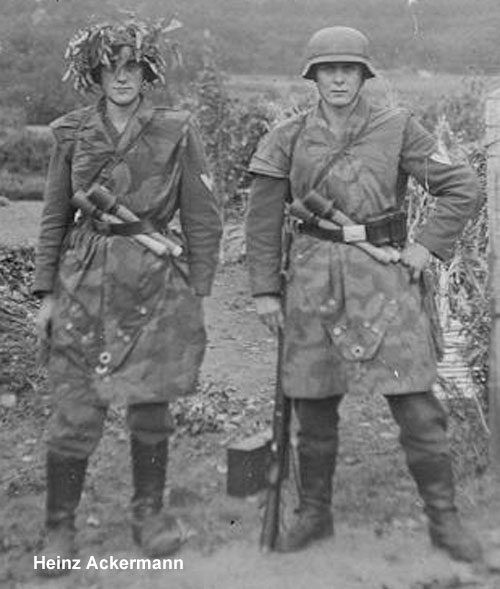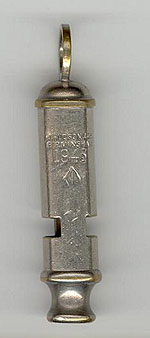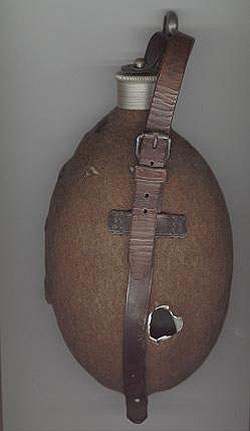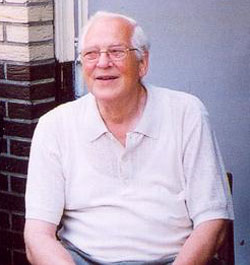Name: Heinz Ackermann
Rank: Obergefreiter
Unit: Unteroffierzierschule der Luftwaffe für Nachtjagd
Regiment: Kampfgruppe Weber

14 days before the British Para's landed on the 17th of September near Arnhem, I was Obergefreiter bei der Luftwaffe and was stationed at the 'Unteroffierzierschule der Luftwaffe für Nachtjagd'. The school was based in an old Dutch school building somewhere at Arnhem. The aprox. 100 men were being trained to operate the radar units 'Würzburg-Riese & Freya'. Our base would become 'Teerose 1'. On the 17th of September suddenly, during the training, there was alarm and we went in our positions immediately. There were attacks from some English enemy fighter bombers. We shot at them with our machineguns. The alarm still went on, when in the afternoon the first paratroopers landed. We shot at them too, with our machineguns and rifles.
The photo below shows me and a comrade and was taken on the 17th !! near the school at Arnhem. On the 18th the supremacy in the air of the Allies was very oppressing. We often were shot at by enemy fighters. Then, during this confusion on the German side, there was the order to leave the school and go west, direction Duisburg. Me and some of my comrades got the order, to blow up this school building. We laid explosive devices and supplied them with time-ignitions. The ignitions had about 15 min delay. During these 15 min, we ran through the area to warn the Dutch civilians that this school would be blown up immediately. The confusion on the German side still lasted on and so we went east, marching most of the day on the 19th.
 On the 20th when we were a few kilometers behind Arnhem, we were gathered and put under the command of the Waffen SS - Frundsberg.
At the same night, the transportation with the armored troop carriers of the Waffen SS - Frundsberg started.
We went to Nijmegen to stop the Allies from capturing the bridge there.
On the 21st we had our first fights with troops in the area of Nijmegen, where we captured some prisoners of war.
From a British Officer, I took his whistle as a souvenir. (see picture on the right, engraving: J.Hudson&C°, Birmingham 1943).
Then we heard that Polish paratroopers had landed in Driel. After that, they were looking for volunteers,
to start an attack on Driel and we moved to Arnhem again. The other afternoon (22.09.1944), we went over the Bridge of Arnhem;
there laid the burnt and killed in action comrades of the Waffen SS - Hohenstauffen.
Later we gathered near Driel and there we were combined with the storm troopers of the Waffen SS. Our position was about 300m apart from the village.
There I met a Dutch family, who had been looking for shelter in one of the trenches and now had got right in the middle of the battle area.
The man‘s arm was hurt seriously. A comrade and me quickly bandaged his arm and we helped them, to get through the fences, to reach the area behind
the battle line. Then our Sergeant Major (Spieß) gave us the order to attack. He shouted: 'Vorwärts Jungs, ran...!' (Go ahead comrades, ...), then a bullet hit his head.
On the 20th when we were a few kilometers behind Arnhem, we were gathered and put under the command of the Waffen SS - Frundsberg.
At the same night, the transportation with the armored troop carriers of the Waffen SS - Frundsberg started.
We went to Nijmegen to stop the Allies from capturing the bridge there.
On the 21st we had our first fights with troops in the area of Nijmegen, where we captured some prisoners of war.
From a British Officer, I took his whistle as a souvenir. (see picture on the right, engraving: J.Hudson&C°, Birmingham 1943).
Then we heard that Polish paratroopers had landed in Driel. After that, they were looking for volunteers,
to start an attack on Driel and we moved to Arnhem again. The other afternoon (22.09.1944), we went over the Bridge of Arnhem;
there laid the burnt and killed in action comrades of the Waffen SS - Hohenstauffen.
Later we gathered near Driel and there we were combined with the storm troopers of the Waffen SS. Our position was about 300m apart from the village.
There I met a Dutch family, who had been looking for shelter in one of the trenches and now had got right in the middle of the battle area.
The man‘s arm was hurt seriously. A comrade and me quickly bandaged his arm and we helped them, to get through the fences, to reach the area behind
the battle line. Then our Sergeant Major (Spieß) gave us the order to attack. He shouted: 'Vorwärts Jungs, ran...!' (Go ahead comrades, ...), then a bullet hit his head.
 After we forced our way into the village, the close combat started. We spread out on the right and the left side of the road. The men on the right side,
were shooting left into the windows, the men on the left side were shooting right. Inside of the houses there were several close combats. In one of the houses,
I saw laying a Polish soldier, his radio was still on, but he obviously had been killed in action during our assault. The battle went on during the whole
afternoon and the Polish Paratroopers defended themselves fanatically. But after some time our zest got lost, and many comrades were killed in action.
After we forced our way into the village, the close combat started. We spread out on the right and the left side of the road. The men on the right side,
were shooting left into the windows, the men on the left side were shooting right. Inside of the houses there were several close combats. In one of the houses,
I saw laying a Polish soldier, his radio was still on, but he obviously had been killed in action during our assault. The battle went on during the whole
afternoon and the Polish Paratroopers defended themselves fanatically. But after some time our zest got lost, and many comrades were killed in action.
Suddenly we were attacked by heavy rifle-fire and we could get no further. One of the best positions, to survey the street, had been taken by an enemy observer. From one side of the house, I tried to get near this soldier, but I didn’t know where exactly he was, because nobody had seen him yet. When I carefully looked around the edge of the house, I suddenly felt a hard strike on my rifle, which had been directly hit on the butt and it just missed my handgrenade. At the same moment, I saw a barrette disappearing into an fox hole. I could not retreat at that moment because that part could be overseen by the enemy. So I threw my first handgrenade towards the foxhole but I missed. The second one landed exactly in the foxhole and I will never forget the scream from the enemy hiding in the foxhole, when my grenade landed in it.
 Now, the way was free. This action had been watched by a Second Lieutenant, who had been hiding in a
house near me. Because of the statement of this Second Lieutenant, I became Lance-Sergeant
on the 01.10.1944, for courage in front of the enemy. A little later I found a
machine-gun (MG15) and ammunition. The attack still lasted on. After some time, I
didn’t know why, I was alone. Now, I had to get through alone to the gathering place.
When I proceeded forwards I met two other comrades. Near Driel, we met a Polish
Lieutenant, who had been laying together with an injured comrade in the trench. We dressed
his wounds and sent him back about 100m and he safely reached the other side. Paratroopers
like him, fought very fair, so we didn’t shoot at him because he could bee recognized
clearly as an injured person.
Now, the way was free. This action had been watched by a Second Lieutenant, who had been hiding in a
house near me. Because of the statement of this Second Lieutenant, I became Lance-Sergeant
on the 01.10.1944, for courage in front of the enemy. A little later I found a
machine-gun (MG15) and ammunition. The attack still lasted on. After some time, I
didn’t know why, I was alone. Now, I had to get through alone to the gathering place.
When I proceeded forwards I met two other comrades. Near Driel, we met a Polish
Lieutenant, who had been laying together with an injured comrade in the trench. We dressed
his wounds and sent him back about 100m and he safely reached the other side. Paratroopers
like him, fought very fair, so we didn’t shoot at him because he could bee recognized
clearly as an injured person.
Now, it was the turn to us, to get over the battlefield. When we started to run, we were shot from aside by machineguns. The shots were all well aimed and missed me only 20 - 30 cm. While I took cover, some shots came close behind me, one hit my drinking bottle, which I kept on my belt (I still have it today, see photo, left). Now I had not only lost my rifle and two handgrenades but also lost my water.
Meanwhile we were also shot by trench mortars. Finally I managed, to cross the battlefield and get shelter. When we came near the end of the grassland there was a small stream of about 2 meters wide we had to cross. I made it in one jump. The Lieutenant behind me, tried to jump over the stream when a shell detonated behind him and killed in mid air during his jump. Parts of his body flew everywhere, his body landed in the stream and he went under without having said one word. Next, I threw some machinegun-magazines into the brook, to be lighter. All the time, I’ve had 5 magazines with me, but now, I only let one in the machinegun and took another one with me. After some time, I reached the gathering-place, but I didn’t meet many of my comrades any more. Most of them had been wounded and many of them had been killed in action. I was the only one of my troop, who got through this day without any injuries.
 On the 23rd we gathered at the position called 'Teerose 1', From
there I got the order to get in touch with the Isle of Walcheren.
On the 23rd we gathered at the position called 'Teerose 1', From
there I got the order to get in touch with the Isle of Walcheren.
There I had to pilot by radio the Airforce of night-chase in the battle against Allied airplanes. And therefore, the battle of Arnhem was over for me.
On the 2nd November 1944, the Canadian soldiers landed on the Isle of Walcheren and I was taken prisoner (POW). At that time, the World War II was over for me. My captivity I spent in England, near Nottingham. In June 1946 I got back to Germany. I think very highly of the British and Polish Paratroopers who fought brave and also decent. Having to go thrue this terrible war I hope it will never happen again.
Yours truly:
Heinz Ackermann
Editor: photo of Mr. Heinz Ackermann today.
At the moment of writing Mr. Ackermann is 84 years old and living in Germany in good health.


















